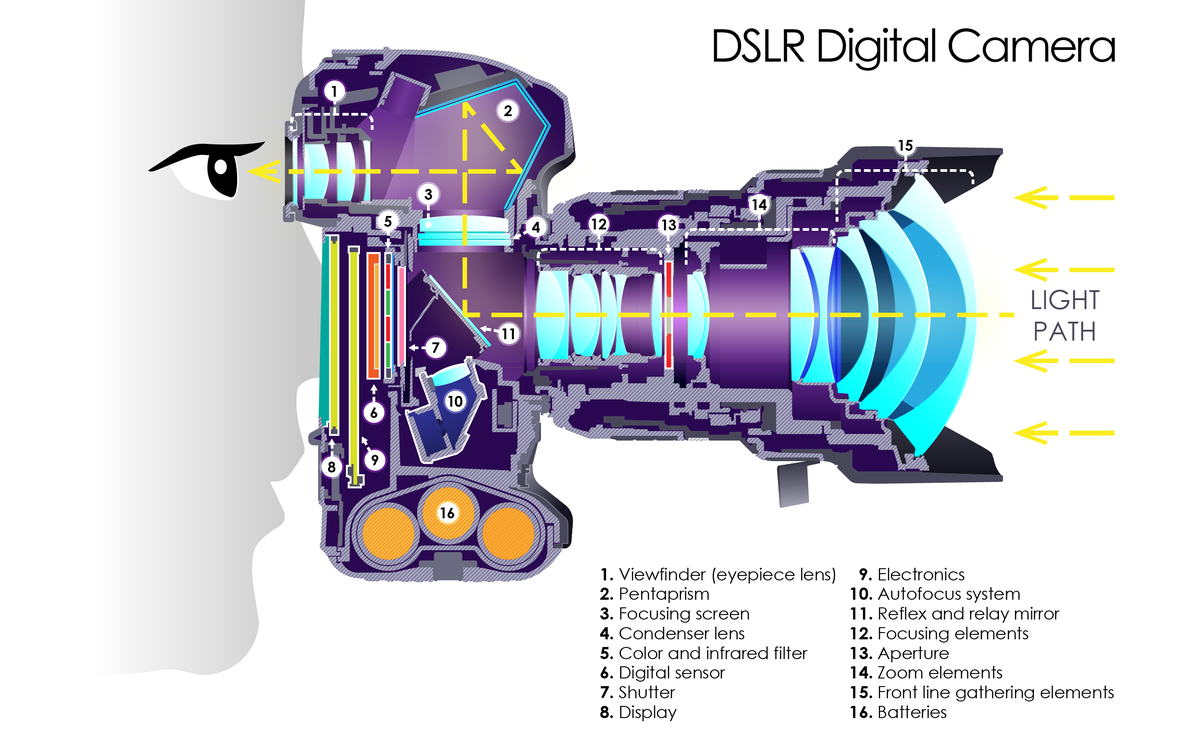Video
A theory of imaging
When light reflects off objects, it carries information about their colors and shapes. Light travels in straight lines, and when it enters a chamber through a pinhole, it creates an image of the scene outside on the opposite wall of the chamber. The image formed is upside-down due to the way light rays travel and intersect. This principle was used to build the very first archetype of cameras approximately 500 years ago - the camera obscura (one is installed next to to the Marburger castle)1. IIn today’s cameras, instead of projecting onto a wall, the light is directed onto a light-sensitive material, which can be either a digital sensor or film. When you press the shutter button on a camera, it opens a shutter to allow light to pass through the lens onto the film or sensor for a predetermined amount of time. This exposes the light-sensitive surface to the scene being photographed. The light entering the camera carries information about the colors and shapes of the objects and causes either a chemical reaction, if the light-sensitive surface is film, or generates an electrical signal in a digital sensor, which is then processed and converted into digital data.
If you want a vivid explanation, click here2

Let’s go through it step by step:
1) The light enters the camera through a lens, which usually includes several glass elements to focus the light at a certain distance. This focal length directly affects the perspective and magnification of the captured image. Shorter focal lengths (wide-angle lenses) provide a wider field of view and greater depth of field, making them suitable for landscape photography. Longer focal lengths (telephoto lenses) narrow the field of view and magnify distant subjects, making them ideal for photography of individual organisms. By moving these elements, the focus can be shifted. Modern cameras usually offer autofocus systems, which automatically adjust the focus based on analysis of the scene or user input.
2) The aperture, whose size can often be controlled, determines the amount of light. A larger aperture allows more light through, resulting in brighter images, while a smaller aperture lets less light through, leading to darker images. The aperture also controls the depth of field, determining which areas in the image appear sharp. A larger aperture (smaller f-number) results in a shallower depth of field, emphasizing the main subject while blurring the background. A smaller aperture (larger f-number) increases the depth of field, keeping more objects in focus in both the foreground and background.
3) The shutter, which opens and closes, controls the exposure time. The shorter the exposure time (e.g., 1/1000 second), the sharper the images of quickly moving objects, but also less light is captured, resulting in a darker exposure.
4) The sensor captures the light, as explained earlier. Each individual pixel on the sensor is sensitive to light and generates an electrical charge when struck by photons. Additionally, the sensor typically contains a color filter array (CFA) placed on top of the light-sensitive elements. The most common type of CFA is the Bayer filter array, which consists of red, green, and blue color filters arranged in a specific pattern. When light enters the camera through the lens, it passes through the color filter array before reaching the light-sensitive elements of the sensor. Each color filter allows only a specific range of wavelengths of light to pass through. Red filters allow red light to pass through, green filters allow green light, and blue filters allow blue light. The sensors have given values for their sensitivity to light (ISO). The higher the ISO, the brighter the images become, but at the price of increased noise.
It is important to tailor these aspects to your needs. Here3 is a guide to help you select the important bits, though it is hard to achieve best results when working on a budget.
QUESTION
- how do your needs differ when your target is an insect vs a mammal?
- in what other ways could behavior and biology of your target affect your camera choice?
